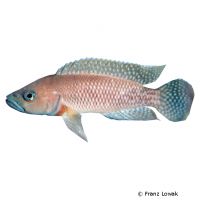Darkbrown Lamprologus (Neolamprologus niger)
| Darkbrown Lamprologus Neolamprologus niger | |
|---|---|
| Name | Darkbrown Lamprologus |
| Name Lat. | Neolamprologus niger |
| Synonym | Lamprologus niger |
| Family | Cichlids |
| Family lat. | Cichlidae |
| Order | Cichlids |
| Order lat. | Cichliformes |
| Origin | Lake Tanganyika |
| Habitat | Intermediate zone |
| Diet | Carnivore |
| pH | 7.5-9.0 |
| Behavior | Semi-aggressive |
| Keeping | Pair |
| Care Level | Moderate |
| Reproduction | Cave spawner |
| Breeding | Moderately difficult |
| Life Span | 6-8 years |
| Protection | No |
| Metric Units | |
| Size | 8-10 cm |
| Temperature | 24-28 °C |
| Hardness | 15-18 °dH |
| Aquarium | ~ 200 l |
| US Units | |
| Size | 3"-4" |
| Temperature | 75-82 °F |
| Hardness | 267-320 ppm |
| Aquarium | ~ 50 gal |
Distribution and habitat
The distribution area of the Dark Brown Lamprologus is exclusively (endemic) the north of Lake Tanganyika, excluding Burundi. They prefer to live near the rocks, crevices and caves, in the transitional entrance area from the rocky to the sandy littoral.
Maintenance
The aquarium setup should have rocky structures that reach the water surface, with plenty of caves, crevices and shelters to provide hiding places, as well as some free sand areas and adequate swimming space.
No ammonia, ammonium or nitrite should be detectable, and the nitrate value should not exceed 100 mg/l. To ensure the water quality and oxygen content, a filter and heater adapted to the aquarium size is required, as well as lighting for the species-appropriate day-night rhythm of the animals.
Diet
In the wild they feed mainly on small crustaceans, insect larvae and small snails. The food supply consists of live, frozen and dry food. For a balanced diet, feed once a day with a high-quality dry food for Tanganyika cichlids (flakes, granules, pellets) as well as cyclops, daphnia, artemia and mosquito larvae (live or frozen)
It is recommended to feed small portions several times a day. Only feed as much as will be eaten within a few minutes. A regular and varied diet promotes health and prevents deficiency symptoms.
Behaviour and compatibility
They should be kept in pairs. The territorial males behave very aggressively within the species, but also defend their territory emphatically against other species. Keeping several pairs is only recommended in a much larger and richly structured tank. They can be socialized with other robust Lake Tanganyika cichlids.
Basically, only compatible fish species with similar demands on water condition and water temperature may be socialized.
Sex dimorphism
The sexes are difficult to distinguish. Adult males are slightly larger than females. With some experience, the sexes can be distinguished by their genital papilla, which is pointed in the male.
Reproduction and breeding
They are pair-building cave breeders and usually attach the spawn to the cave ceiling or walls. The female performs brood care while the male defends the territory. The fry hatch after 2-3 days and swim free after 6-8 days. They are cared for by the parents for a short time before brood care ends.
Fry must be fed several times a day with special rearing food (Artemia nauplii). In community tanks breeding is hardly possible, because the fry are easy prey.
Important
With increasing age the coloration changes from yellow mostly to dark brown. They hardly show any color differences in their range.
The well-being of the fish should be checked regularly. Temperature should be checked daily, pH, hardness and nitrate value at least every 14 days. A regular partial water change is recommended, even if the pollutant load has not yet reached the upper limit. Sudden changes in water quality should be avoided. Newly introduced fish must be accustomed slowly to the water in the aquarium.
Further literature can be found in your pet store.
References
Text: Werner Winter; Image: Franz Lowak
Source: BMELV (1998): Tierschutzgutachten - Haltung von Zierfischen (Süßwasser); BAENSCH & RIEHL (2004): Aquarien Atlas Bd. 4, Mergus Verlag; ENGELMANN (2005): Zootierhaltung - Tiere in menschlicher Obhut: Fische, Verlag Harri Deutsch
- Gemäß § 21 Abs. 5 Tierschutzgesetz idgF
